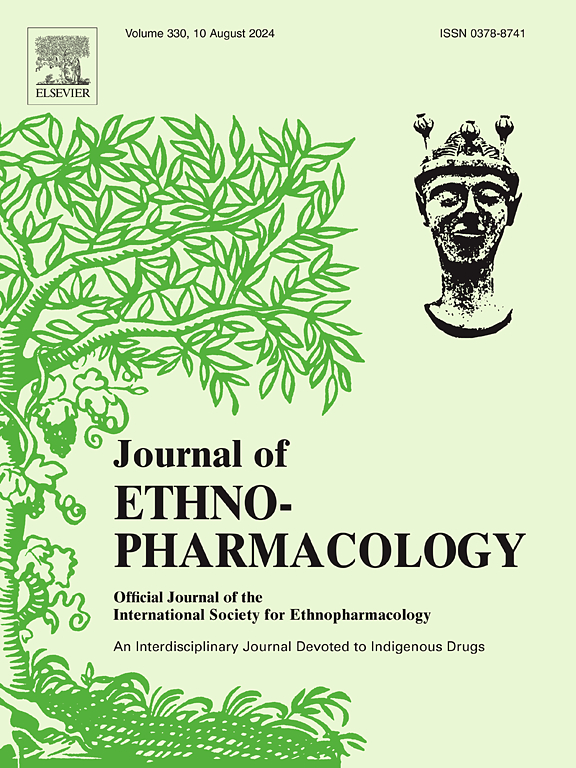Huangqin decoction alleviates chemotherapy-induced intestinal injury by inhibiting ferroptosis via modulation of P53/SLC7A11/GPX4 pathway
IF 5.4
2区 医学
Q1 CHEMISTRY, MEDICINAL
引用次数: 0
Abstract
Ethnopharmacological relevance
Huangqin Decoction (HQD), a traditional Chinese medicine formula for the treatment of heat-induced diarrhea and dysentery. HQD can significantly reduce chemotherapy induced intestinal toxicity. However, the underlying mechanism of HQD in alleviating chemotherapy-induced intestinal injury remains unclear.
Aims of the study
To explore the underlying mechanism of HQD against chemotherapy-induced intestinal injury through the P53/SLC7A11/GPX4 signaling pathway-mediated ferroptosis.
Materials and methods
Irinotecan (CPT-11) was used to establish chemotherapy-induced intestinal injury model in mice. The inflammatory damage of the jejunum and colon is evaluated by HE staining and ELISA. The degree of ferroptosis is validated by the iron deposition, the levels of ROS, MDA, SOD and GSH, and the changes in the distribution of 4-HNE and iron in the jejunum and colon. Expression of intestinal tight junction protein TJP-1 and Occludin was detected by immunofluorescence. The P53/SLC7A11/GPX4 signal pathway was examined by RT-qPCR and Western blot.
Results
HQD significantly decreased diarrhea scores in chemotherapy mice, and improved the inflammatory pathological damage, with decreased levels of IL-1β and TNF-α. HQD also restored intestinal barrier function and intestinal tight junction protein TJP-1 and Occluding expression. Furthermore, HQD significantly suppressed ferroptosis, as indicated by the improvement of iron deposition, and oxidative stress. The PCR and Western blot results indicated that HQD could activate the P53/SLC7A11/GPX4 signaling pathway.
Conclusion
The occurrence of chemotherapy-induced intestinal injury is associated with ferroptosis-induced intestinal inflammation; HQD prevent chemotherapy-induced intestinal injury by activating the p53/SLC7A11/GPX4 signaling pathway, inhibiting ferroptosis, and alleviating intestinal inflammatory injury.

黄芩汤通过调节P53/SLC7A11/GPX4通路抑制铁下垂,减轻化疗诱导的肠道损伤
黄芩汤(HQD)是一种治疗热致腹泻和痢疾的中药方剂。HQD可显著降低化疗引起的肠道毒性。然而,HQD减轻化疗引起的肠道损伤的潜在机制尚不清楚。本研究目的探讨HQD通过P53/SLC7A11/GPX4信号通路介导的铁凋亡,对抗化疗诱导的肠道损伤的潜在机制。材料与方法采用siinotecan (CPT-11)建立小鼠化疗诱导肠道损伤模型。采用HE染色和酶联免疫吸附法评价空肠和结肠的炎症损伤。铁下垂程度可通过铁沉积、ROS、MDA、SOD和GSH水平以及空肠和结肠中4-HNE和铁分布的变化来验证。免疫荧光法检测小肠紧密连接蛋白TJP-1和Occludin的表达。采用RT-qPCR和Western blot检测P53/SLC7A11/GPX4信号通路。结果shqd可显著降低化疗小鼠腹泻评分,改善炎性病理损伤,降低IL-1β和TNF-α水平。HQD还能恢复肠道屏障功能和小肠紧密连接蛋白TJP-1和occlding的表达。此外,通过改善铁沉积和氧化应激,HQD显著抑制铁下垂。PCR和Western blot结果显示,HQD可激活P53/SLC7A11/GPX4信号通路。结论化疗致肠道损伤的发生与铁中毒致肠道炎症有关;HQD通过激活p53/SLC7A11/GPX4信号通路,抑制铁下垂,减轻肠道炎症损伤,预防化疗诱导的肠道损伤。
本文章由计算机程序翻译,如有差异,请以英文原文为准。
求助全文
约1分钟内获得全文
求助全文
来源期刊

Journal of ethnopharmacology
医学-全科医学与补充医学
CiteScore
10.30
自引率
5.60%
发文量
967
审稿时长
77 days
期刊介绍:
The Journal of Ethnopharmacology is dedicated to the exchange of information and understandings about people''s use of plants, fungi, animals, microorganisms and minerals and their biological and pharmacological effects based on the principles established through international conventions. Early people confronted with illness and disease, discovered a wealth of useful therapeutic agents in the plant and animal kingdoms. The empirical knowledge of these medicinal substances and their toxic potential was passed on by oral tradition and sometimes recorded in herbals and other texts on materia medica. Many valuable drugs of today (e.g., atropine, ephedrine, tubocurarine, digoxin, reserpine) came into use through the study of indigenous remedies. Chemists continue to use plant-derived drugs (e.g., morphine, taxol, physostigmine, quinidine, emetine) as prototypes in their attempts to develop more effective and less toxic medicinals.
 求助内容:
求助内容: 应助结果提醒方式:
应助结果提醒方式:


